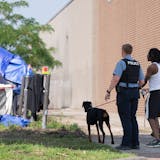Buildings should be able to withstand all sorts of disasters, says Doug Pierce, senior associate and architect at Perkins+Will's Minneapolis office.
And not all of them have to be natural.
Pierce is the developer behind the RELi (pronounced rely) standard. It is a design rating and certification system that attempts to show how resilient a building or neighborhood is from disturbances. Extreme weather can be an example, but Pierce and his colleagues are encouraging builders and developers to also prepare for a wider variety of possibilities: from accidents involving hazardous materials to sudden changes in the economy or civil disturbances.
"Resiliency is about bouncing back from shocks," Pierce said.
Earlier this month, the RELi standard was adopted by the Green Business Certification Inc. (GBCI), the same group that administers LEED, a system that rates a building's environmental characteristics.
In collaboration with its sister organization, the U.S. Green Building Council (USGBC), GBCI is working to further refine RELi. Pierce is chairman of a national steering committee to develop the RELi system and spread it globally.
Pierce, who teaches a sustainability course at the University of Minnesota, started to think more about building resiliency following a series of shocks, including the economic downturn in 2008 and the floods in Duluth in 2012, that caused $100 million worth of damage.
Pierce connected with Mike Italiano, the president and chief executive of Washington, D.C.-based Institute for Market Transformation to Sustainability, to form a committee that worked over the course of two years to develop the RELi standards, which they published in 2014. It took another few years of promoting their standards to industry thought-leaders to build support before the USGBC decided to officially adopt the standards.

